Burberry (1856 est.) -164 years old or phoenix in the digital world?
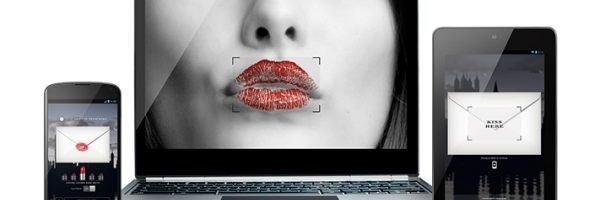
When even iPhones did not exist – is when Burberry started thinking of Digital Transformation. The journey that this 100+ years old company took is inspiring and tells us what a winner looks like in this world of Digital Darwinism.
It was in 2006 when Burberry’s new CEO, Angela Ahrendts[i], faced the challenge of fading identity of this iconic brand which was once well known for its fancy trench coats. Rapid rise in licensing agreements in the last decades led to having the brand name on literally everything from hand-bags to belts, throw pillows, boxer shorts, cookies, fragrances, liquor, stuffed toys and watches. There were even co-branded VISA credit cards that displayed the Burberry logo.[ii]
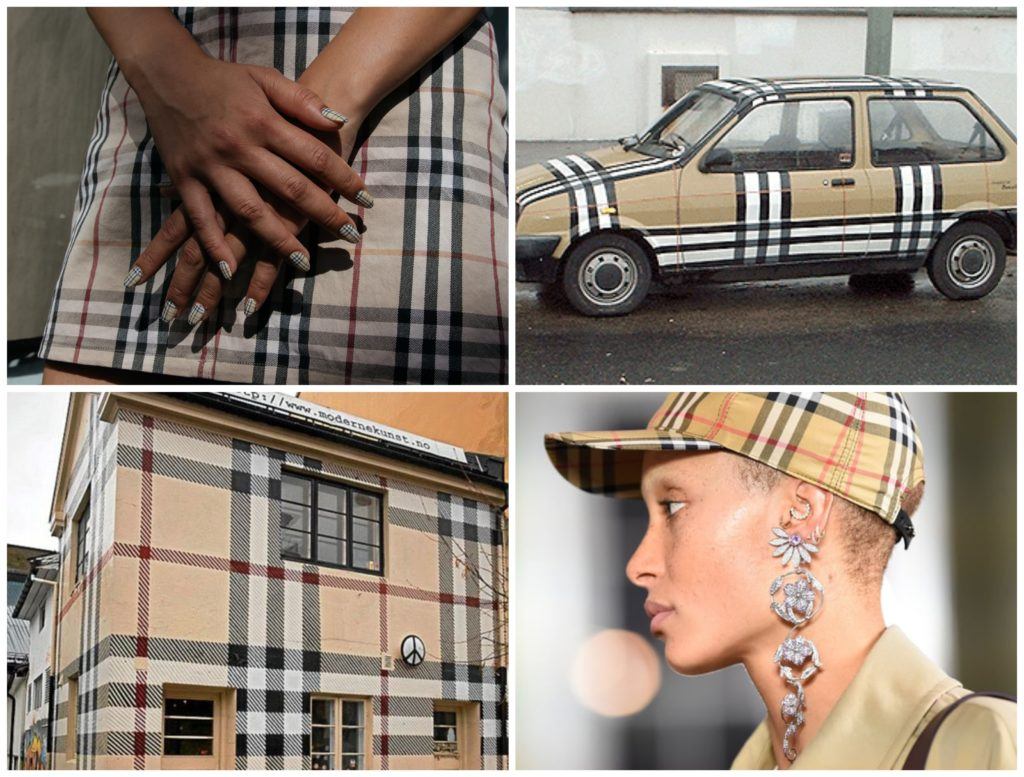
Ahrendts recalled – “We had 23 licensees around the world, each doing something different. We were selling products such as dog cover-ups and leashes. In luxury, ubiquity will kill you. Burberry needed to be more than a beloved old British company”[iii]
#1: Techie’s voice for branding
To bring back control on designs, Ahrendts first appointed a “brand czar”,Christopher Bailey, a techno-enthusiast who hired people from gaming companies and coders along with traditional designers.[iv]
#2: Where can you find millennial? On the screens!
While fast-fashion brands such as H&M and Zara thought of millennial as “cheap”, Ahrendts and Bailey saw these millennial as potential buyers for their luxury goods. They figured that to talk to these 20-somethings, they needed to communicate in their language and that language was digital.[v] They declared that they wanted Burberry to become “the first fully digital luxury company.”[vi]

#3 Social media as the way to go
2006 was early to think about digital. iPhones and Instagram did not even exist back then! But Burberry was thinking ahead.
Burberry’s digital transformation started with investments in technology, particularly a multi-year effort to consolidate its systems and make its global operations transparent.[vii] Having a foresight of where the world was heading, Burberry was one of the first luxury brands to join Facebook in 2009.[viii] Over the years Burberry was active on all social platforms – Twitter, Facebook, YouTube, Instagram, Google+, Pinterest, Tumblr, Polyvore, Vine, Weibo, YouKu, WeChat and others.[ix] By 2012, Burberry spent 70% of its marketing budget on digital media.[x]
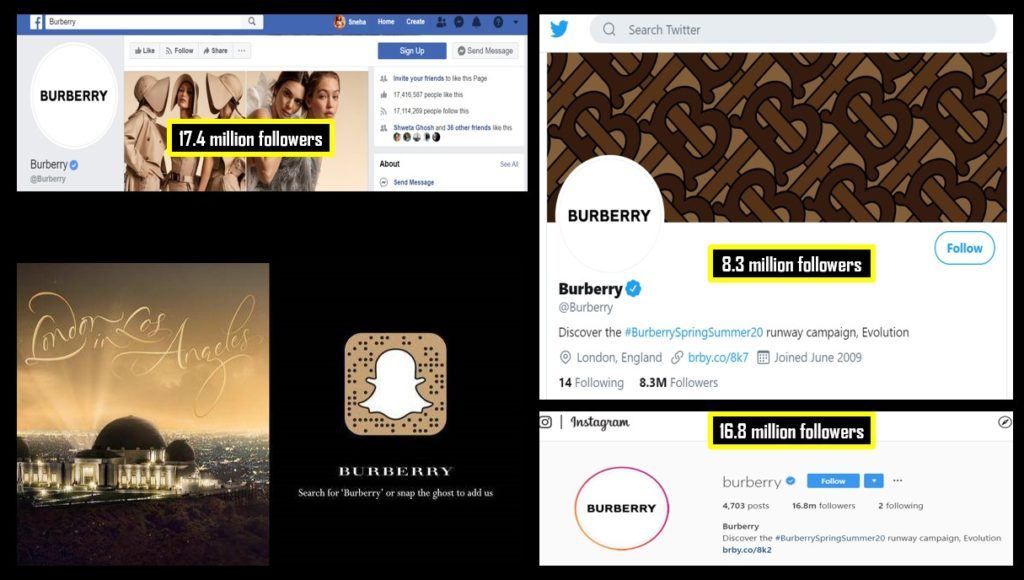
Burberry used these platforms to connect with its fans by sharing their runway shows, updates on new collections and gathering feedback. Its high activity (5 posts/day on Twitter, and up to 10 during London Fashion Week[xi]) and initiatives such as Tweetwalk, enabling followers to see images of its collections before they went down the runway[xii], Tweet-activated cameras during catwalks, partnership with Japanese messaging platform “Line” to live stream the show for Line’s 180 million active monthly users appealed to millennial and kept them engaged.[xiii] In 2014, it pioneered a new “Buy now” button to sell directly from Twitter.[xiv] It was equally engaged on other platforms. E.g. Burberry’s Spring/Summer 2013 campaign video gained over 1 million YouTube views in just 48 hours.[xv]
In 2009, it delved into crowd-sourcing by introducing its website “The Art of the Trench”, inviting everyday people to post their photographs in Burberry coats.[xvi]
# Seamless omni-channel experiences
Realizing that the millennial seamlessly traverse through the online and offline worlds, Burberry opened its first tech-enabled flagship store in London’s Regent Street in 2012. This 44,000-sq. Ft. space boasted the tallest indoor retail screen in the world, a digitally enabled gallery, 500 speakers, 100 screens, mirrors that instantaneously changed into screens, RFID-tagged apparel that enabled bespoke multi-media content based on what customers touched and store staff equipped with iPads. [xvii]
“Burberry Regent Street brings our digital world to life in a physical space for the first time, where customers can experience every facet of the brand through immersive multimedia content exactly as they do online,” said Angela Ahrendts. “Walking through the doors is just like walking into our website.”[xviii]
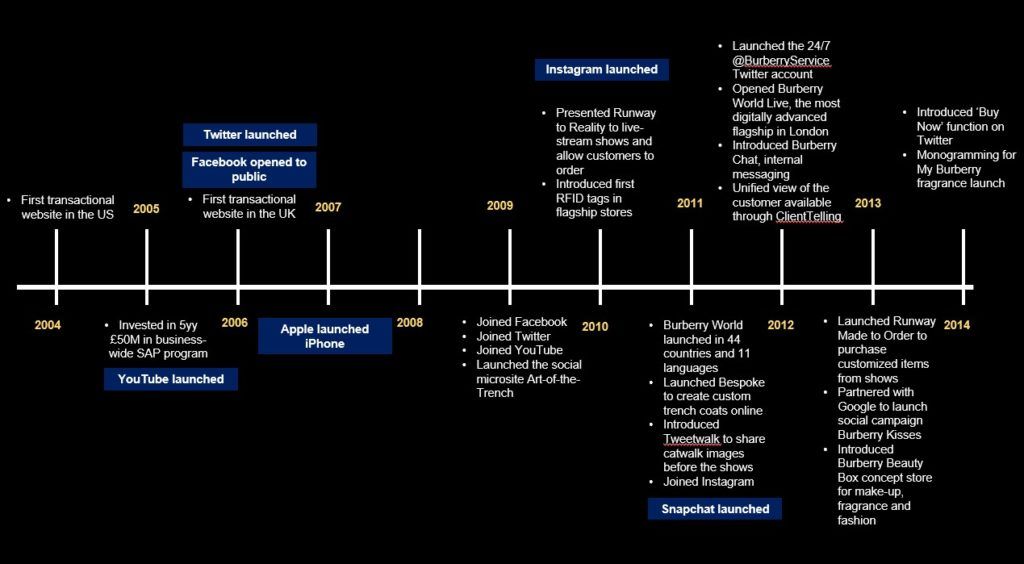
Angela Ahrendts’ ability to tap into the latest generation (gen Y and Z) of digital consumers who use online media to follow trends, engage, socialize as well as make purchases helped Burberry stand apart from its peers and steadily grow over the years.
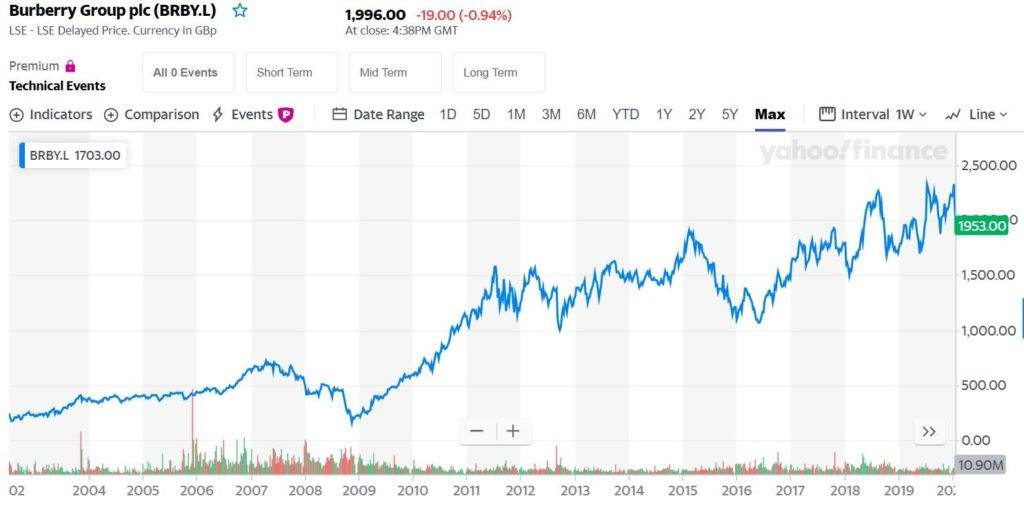
Smooth road ahead?
While Burberry’s entry into the nascent digital world made it an endearing brand among its young, loyal customers, it could face significant challenges ahead. Higher pace of innovation and new revelations about what’s possible in the digital world has helped its luxury peers (e.g. LVHM and Gucci) catch up. Burberry needs to continue being ahead of the curve to reap the benefits of being the digital winner.
Finally, I want to leave you with one of my favorites of their digital initiatives – Burberry Kisses. In partnership with Google, Kisses was launched in 2013, aimed to “humanize technology” through emotive digital experiences – taking the lip contact from your real-life kiss and transforming it into a digital kiss print and sent to anyone in the world.[xix]
Isn’t it beautiful?
Word count: 780
Sources
[i] Bloomberg.com. Bloomberg. Accessed February 11, 2020. https://www.bloomberg.com/profile/person/2065695.
[ii] Christiansen, Bryan, Salih Yildiz, and Emel Yildiz. Transcultural Marketing for Incremental and Radical Innovation, Chapter 10, The Strategic Use of Social Media in the Fashion Industry, Hanna Kontu (London College of Fashion, UK) and Alessandra Vecchi (London College of Fashion, UK & University of Bologna, Italy). Hershey, PA: Business Science Reference, 2014.
[iii] Ahrendts, Angela. “Burberry’s CEO on Turning an Aging British Icon into a Global Luxury Brand.” Harvard Business Review, August 1, 2014. https://hbr.org/2013/01/burberrys-ceo-on-turning-an-aging-british-icon-into-a-global-luxury-brand.
[iv] Mower, Sarah. “How Christopher Bailey Transformed Burberry and Redefined Brand Revivals in the 21st Century.” Vogue, November 1, 2017. https://www.vogue.com/article/burberry-christopher-bailey-legacy.
[v] “How Burberry Won Over Millennials.” Bain, February 6, 2019. https://www.bain.com/insights/how-burberry-won-over-millennials/.
[vi] Milnes, Hilary, Deanna Ting, Kristina Monllos, Tim Peterson, Deanna Ting, and Seb Joseph. “How Burberry Became the Top Digital Luxury Brand.” Digiday, March 20, 2017. https://digiday.com/marketing/burberry-became-top-digital-luxury-brand/.
[vii] Westerman, George, Didier Bonnet, and Andrew McAfee. Leading Digital Turning Technology into Business Transformation. Boston: Harvard Business Review Press, 2015.
[viii] Doran, Sophie. “How Burberry Does Digital.” Luxury Society. Luxury Society, March 1, 2018. https://www.luxurysociety.com/en/articles/2014/01/how-burberry-does-digital/.
[ix] Leer, Courtney. “How Burberry Connects With Millennials.” Courtney, September 26, 2014. https://courtneyleer.wordpress.com/2014/08/29/burberrys-social-media-presence/.
[x] Capgemini consulting, January 2, 2012. https://www.capgemini.com/fr-fr/wp-content/uploads/sites/2/2017/07/Digital_Transformation_Review_2.pdf.
[xi] “Case Study: Is Burberry’s Social Media Use the Best Amongst Luxury Brands?” Social Wall, October 4, 2016. https://socialwall.me/en/burberry-social-media-use-luxury-brands/.
[xii] Burberry Group plc, Annual Report and Accounts 2011/12, p.34
[xiii] McCabe, Maisie. “Burberry to Feature Tweet-Activated Camera during Catwalk Show.” Campaign. CampaignUK, April 15, 2015. https://www.campaignlive.co.uk/article/burberry-feature-tweet-activated-camera-during-catwalk-show/1335018.
[xiv] Kilcooley-O’halloran, Scarlett. “Twitter Launches Buy Button.” Vogue, September 9, 2014. https://www.vogue.co.uk/article/twitter-launches-buy-button-with-burberry.
[xv] a McKenzie, Sheena. “Angela Ahrendts: The Burberry CEO Who Reinvented a Heritage Brand for the Digital Age.” CNN Business, October 15, 2013. https://www.cnn.com/2013/10/15/business/the-burberry-ceo-who-reinvented/index.html.
[xvi] “Burberry Checks out Crowdsourcing with The Art of the Trench.” The Guardian, n.d. https://www.theguardian.com/media/pda/2009/nov/09/burberry-art-of-the-trench.
[xvii] “Burberry Regent Street.” Retail Innovation, January 1, 2013. http://retail-innovation.com/burberry-regent-street.
[xviii] Parr, Christopher Parr Christopher, and Christopher Parr. “Inside Burberry’s London Flagship Store.” Pursuitist, September 23, 2012. https://pursuitist.com/inside-burberrys-london-flagship-store/.
[xix] Karmali, Sarah. “Burberry And Google, Sitting In A Tree.” Vogue, June 12, 2013. https://www.vogue.co.uk/article/burberry-kisses-send-a-burberry-kiss-google-technology.



Very well researched article Sneha – thank you! I think this is a fascinating story of a company experimenting with technology and how it can adapt to it. Burberry’s position in the market affords it a certain amount of power, but it is also much smaller than some of the other super luxury brands. I would be fascinated to hear more on how Burberry is using this new stream of customer data to inform its strategy and product development!
Thank you for your comment, Chris. Agreed that Burberry’s position in the market allowed it certain power – but I am not sure if the “millennial” segment that it identified and targeted through technology back in 2006 was where it had a leg-up back then. My feeling is that they created this market for themselves.
Yeah, it would be interesting to see how they use all these years worth of data to outperform their peers and if their strategy is any different from the rest in the years to come.
Very well done, Sneha! I had no idea Burberry was such a pioneer in digital channels.
I can clearly see how the company did a great job in leveraging media to push forward its brand and get closer to its customers. It is clear that Burberry was able to – through its channels – make prospects and clients better experience their brand in the last decade. I wonder, however, if there are more innovative ways to truly bring the Burberry experience online as a product (as opposed to merely advertising it). If there is, my bet is that it would be the new frontier for luxury brands!
Thanks Ricardo! I was actually just thinking about that. One of the blogs here is on Sephora and reading that I realized that most of their digital initiatives are to improve customer experience and deliver better product/service. Very little of the digital space is being used for actual marketing. In contrast, Burberry seems to capture most of the digital space in the form of advertising and marketing. Apart from its high-tech retail store which is blurring the line between physical and digital worlds for its customers, there aren’t much “experience-driven” digital initiatives. Great thought, thanks!
Thank you for the post! I enjoyed learning about what Burberry has been doing differently, in the world of traditional luxury brands. They really did take a risk, compared to many of the other luxury brands. I worked directly and indirectly with many of Burberry’s peers (in a broad sense) while at Alibaba, and I would say most of them were a lot more risk averse, or quite stuck up with their “high-end” brand images and actively avoiding going digital because it’d cheapen their brands. While Burberry is in a middle range position among luxury brands and thus going digital would be an easier decision than for say, Hermes, I still think Burberry was bold and strategic, and it paid off.
Thank you for sharing your experience here, Jack. Yeah, indeed bold to go out there all digital to reach the “masses”, hoping that the right(rich) audience will sieve through. I was particularly surprised by its presence and high activity on SnapChat which in my head is basic – but clearly, they are doing it all right – the stocks say so!
Really interesting article! Thanks for sharing! One piece of this that jumps out to me is the focus on marketing and customer engagement. I wonder, in a world where other apparel retailers offer similar omni experiences, does Burberry successfully differentiate itself through these digital initiatives, or are the digital efforts the new table stakes for competing in the space?
Additionally, where can Burberry go from here? Players like Amazon are entering full force in the space and developing their own private labels using many of the techniques described here with the backing of a strong tech foundation.
Will the brand image be able to prevail? How will the brick-and-mortar footprint adapt to adjust to the dynamic retail marketplace as the industry shifts to embrace digital over time? As a premium brand, how will Burberry balance the old-school, traditional history with the need to attract younger customer segments used to digital-first strategies?
Clearly, the company has navigated the transition well and is implementing unique and creative digital solutions. It will be interesting to see how these offerings continue to evolve as competitors catch up.
Thanks for your comments and questions, @iBot. Indeed it will be interesting to see where Burberry goes from here. I think they have been able to spot trend early on which enabled them to lure the millenial through digital marketing and their digital retail stores. With higher spending trends among young people, compared to the previous generation – luxury brands do not need to wait for people to reach their 50s to buy their first Burberry coat. Do they really need to balance their old-school, traditional history if they are able to create a brand identity for right set of customers willing to spend on their products? Also, these millenials are the future – grabbing their attention early could help the company keep them engaged through their later years too possibly.